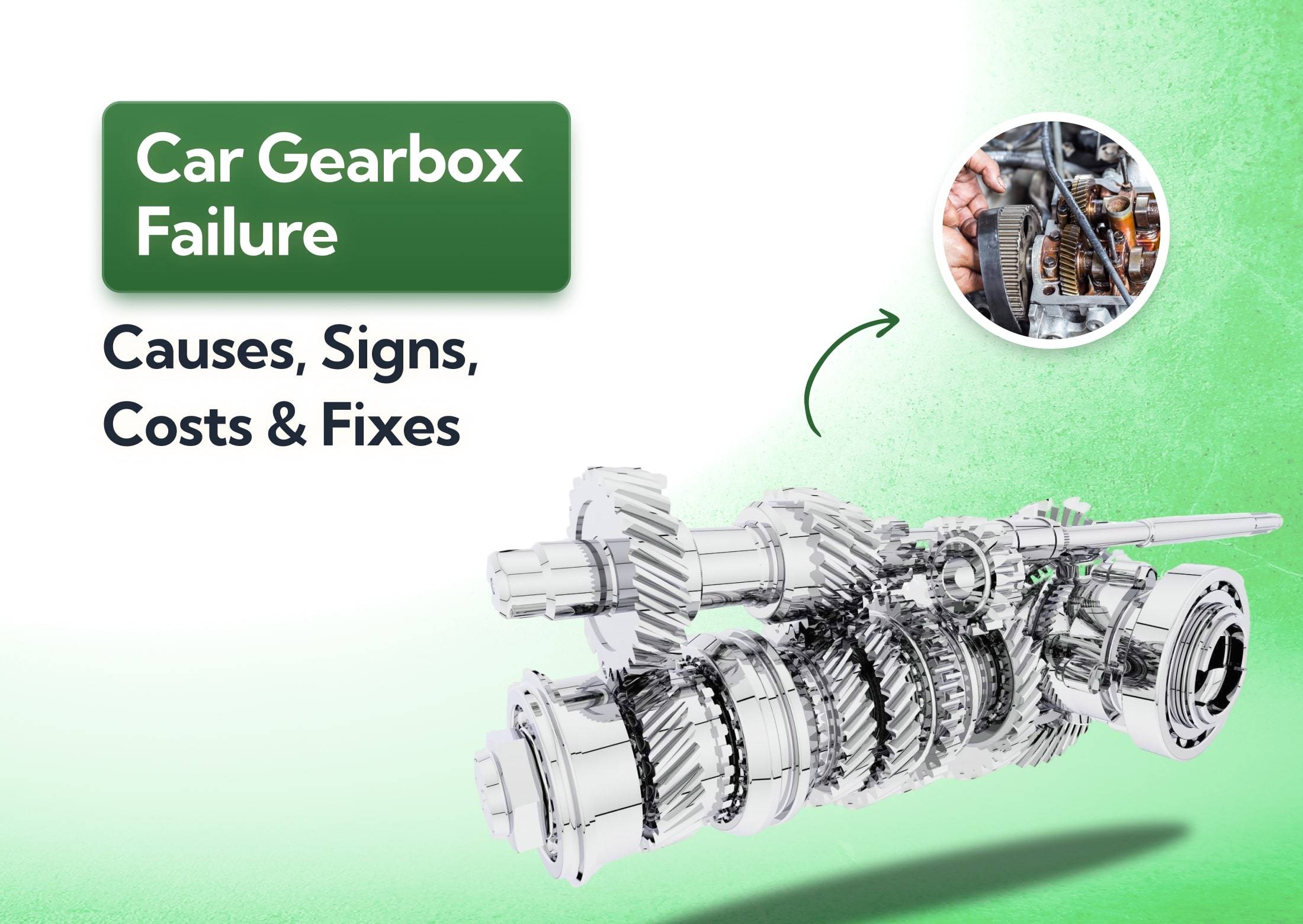Car Gearbox Failure: Causes, Signs, Costs and Fixes
Gearbox trouble turns a smooth drive into a stressful one fast. This guide helps you spot the gearbox failure signs early, understand your repair and replacement options and decide whether repairing, replacing or scrapping the car makes the most sense.
Last updated: 25th November, 2025

Award-winning CEO driving growth and social impact across automotive, recycling, and technology-led enterprise platforms.

Listen to this story
A failing gearbox is one of those problems you hope you never face, because it touches nearly every part of how your car drives. When it starts to go wrong, you feel it. Gear changes become rough, the car hesitates or you hear noises that make you instantly lower the radio volume.
Most drivers here in the UK only think about the gearbox when something feels off. That’s fair; it’s not a component you service every weekend. But when issues show up, they snowball rather quickly.
A slight crunch today can turn into a slipping gear next month. And eventually you’re dealing with a repair bill that makes you question whether the car’s even worth keeping.
This guide breaks everything down in plain language. You’ll learn the common symptoms, what usually causes gearbox failure, how much repairs tend to cost in the UK and the realistic options for fixing or replacing one.
What's in this article
- 1. What is a gearbox and what are its types?
- 2. What are the common causes of gearbox failure?
- 3. What are the signs of gearbox failure?
What is a gearbox and what are its types?
A gearbox is the part of your car that captures engine power and transfers it from the engine to the wheels. Engines only work well within a certain rev range, so the gearbox adjusts the ratio between engine speed and wheel speed to keep everything running smoothly. Without it, the car would either stall constantly or scream its head off at even modest speeds.
There are several types of gearboxes and each one behaves differently.
- Manual gearbox: You choose the gear yourself using the clutch pedal and gear lever. They’re simple, durable and cheaper to repair than most alternatives. When they fail, it’s usually from worn synchros, damaged bearings or a clutch-related issue. You’ll usually find them in older cars and driver-focused models (e.g. the BMW M Series).
- Automatic gearbox: These shift for you using hydraulic pressure and internal clutches. They’re what replaces manual transmission in most modern family cars. They’re smooth and convenient but more complicated to repair. Problems here stem from worn clutch packs, faulty solenoids and low or dirty transmission fluid.
- Dual-clutch transmission (DCT): DCTs use two clutches to pre-select gears, giving extremely fast shifts. You see them in performance cars, hot hatches, premium German models and some newer small cars. They’re great when they work but the complexity means repairs are pricey. Clutch and mechatronic failures are the most common issues.
- Continuously variable transmission (CVT): Instead of fixed gears, CVTs use a belt and pulley system for seamless acceleration. They’re smooth to drive and rely heavily on clean proper fluid. You’ll mostly see CVTs in hybrids, economy cars and Japanese brand models. Belt wear and pulley issues are the main failure points.
What are the common causes of gearbox failure?
Most of the time when the gearbox fails, it’s because of worn internal parts, low/dirty transmission fluid, overheating or simple age and mileage catching up with the car. Electrical faults, hard driving, towing heavy loads and ignoring early warning signs also push a gearbox towards failure much faster.
We’ll get into all that below.
Low or contaminated gearbox fluid
Low or contaminated gearbox fluid is one of the quickest ways to damage a transmission because the fluid handles lubrication, cooling and hydraulic pressure.
When the level drops too low or the fluid breaks down, metal parts rub together. The result of this is internal temperatures rise and the gearbox wears itself out far sooner than it should.
If you spot leaks, dark fluid, or a burnt smell, it’s a sign the gearbox needs attention before the damage becomes expensive.
Overheating of the gearbox
High temps are brutal on the gearbox because they thin the fluid and push internal parts far beyond what they’re designed to handle.
- Heavy loads
- Aggressive driving
- Steep hills
- Stop-start traffic
- Towing without the right setup
All of these things cause heat to build until components start to fail. And you’ll know this is the problem because there’ll be a burning smell. Once a gearbox has overheated a few times, wear accelerates quickly and the repair costs usually climb with it.
Clutch problems
In cars with manual transmission, a slipping or poorly adjusted clutch stresses the transmission system because both stop the gears from engaging cleanly.
When that happens, it eventually leads to grinding and makes it hard for the gearbox to switch gears. Not to mention, it puts extra wear on the synchros every time you shift.
Clutch slipping is pretty easy to identify (you’ll hear the noises, feel the vibrations and notice the bad performance). It’s also one of the easiest to prevent; just don’t ride the clutch when you drive.
Wear and tear over time
Every gearbox wears out eventually, even if you drive nice and gently and service it on time, every time. Bearings loosen, synchros slow down, seals harden and internal clutches/sensors become less efficient as you put more miles on the car.
Of course, driving habits do tilt the longevity odds in your favour. But once your car’s 10+ years old or has six figures’ worth of miles on it, the odd crunches and slow gear shifts will tell you: the gearbox is almost at the end of its useful life.
At that point, you’ll either replace the gearbox or, if the maths don’t add up, the car.
Electrical and sensor failures (automatic gearboxes)
If you’re driving an automatic transmission, this is one of the most common faults. Instead of you shifting gears on your own, modern transmissions rely on electronics to control shift timing and fluid pressure as you accelerate.
If the transmission control module doesn’t work like it should, the internal sensors get bad data and you’ll run into problems like gearbox slipping and a refusal to change gears. The car might also drop into limp mode if the system detects (or ‘thinks’ it detects) a critical fault in the transmission system.
You might be able to troubleshoot this on your own if you have an OBD2 scanner, but I’d recommend taking it to the shop to have a professional diagnose it.
Driving style and poor habits
I've already touched on this earlier, but it's worth repeating: driving too harshly will destroy your car’s internals a whole lot faster.
- Hard launches
- Riding the clutch
- Skipping services
- Towing beyond the car’s limits
- Shifting aggressively
All of these things add stress that builds up and compounds over time until something inside finally gives. If you’re aware you have any of these habits, make a conscious effort to fix them.
What are the signs of gearbox failure?
Gearbox failure usually shows up as rough or delayed gear changes, strange noises, slipping, vibrations and/or warning lights on your dash. If the car feels different when shifting and you notice new sounds or hesitations, the gearbox is almost definitely the source.
Fluid leaks
A transmission fluid leak slowly starves the transmission of the fluid it needs for cooling and lubrication. When this happens, shifts feel harsher and the car will hesitate. As time goes on, temperatures climb until parts begin to wear out.
If you see dark red or brown oily patches under the car, check the transmission fluid level. If it’s low, top it up or book the car in quickly to have a mechanic do it, because driving with low fluid can turn a cheap seal replacement into a full gearbox rebuild.
Warning lights on the dashboard
Most cars have a dedicated transmission symbol – something like an amber or red gear-shaped symbol with an exclamation mark inside of it. If this comes on, the car detects a fault in the gearbox or its control system. If not (or in addition to the transmission light), you might notice the engine management light turn on.
If there’s actually a problem, the car will also drop into limp mode to protect itself. Regardless, when you see one of these dashboard lights appear, avoid long drives and get the car checked as soon as you possibly can. Especially if the light’s red instead of amber.
Unusual sounds
Unusual sounds are one of the clearest early warnings that something inside the gearbox isn’t happy.
- Whining points to worn bearings.
- Grinding suggests damaged synchros or gears.
- Clunking hints at excessive play or failing mounts.
Any new noise that gets louder with speed or changes during gear shifts deserves attention. These sounds sometimes appear not too long before the gearbox completely fails. Get the car inspected sooner rather than later to save yourself from a far bigger bill.
Slipping gears
Slipping gears are a major red flag because they mean the gearbox can’t hold the gear you’ve selected. You’ll feel the revs jump unexpectedly, the car may surge or lose power, and the gearbox might drop in and out of gear under load.
Gear slips usually happen when there’s lots of wear on the internal clutch. It can also happen when fluid pressure is low or the synchros can’t lock the gear properly anymore. Once it starts, the problem escalates fast, so take it as a clear sign the gearbox needs immediate attention.
Shaking, jerking or grinding
Shaking, jerking, or grinding usually means something inside the gearbox has already started to wear or fail. It can come from low fluid pressure, worn clutch packs, damaged synchros or gears that aren’t engaging cleanly anymore.
Once the gearbox reaches this point, the problem tends to worsen quickly because every rough shift accelerates the wear on already-weak components. So you should take every symptom seriously, but these ones especially so because they point to internal damage rather than a simple adjustment or sensor fault.
Burning smell
A burning smell almost always points to overheating inside the gearbox. When the fluid breaks down and there isn’t enough lubrication to keep temperatures under control, it burns, producing the smell.
Once you smell burnt transmission fluid, the transmission is already under great stress and continued driving can push it into full gearbox failure. So pull over and call roadside assistance to take the car to the garage.
How much does gearbox repair or replacement cost?
Gearbox repair costs in the UK usually fall between £300 and £1,200 depending on what’s actually gone wrong. A full replacement is far pricier at roughly £800 to £4,000, with some automatic and dual-clutch ones stretching even higher.
The wide range makes sense once you realise how many variables sit behind the final bill: labour time, parts availability, car make/model, the type of gearbox you have and whether the damage is minor wear or a complete internal failure.
Repairing a small leak or replacing a sensor is at the bottom end. Rebuilding a worn manual transmission on a basic car sits at the bottom. Replacing a new high-performance automatic gearbox sits at the top.
Cost of gearbox repair
You can repair a gearbox in most cases if there's a minor issue like worn bearings or seals. Like we just mentioned above, you can normally do so for between £300 and £1,200+.
Here’s a closer look at how that breaks down:
| Repair type | Manual gearbox | Automatic gearbox |
|---|---|---|
| Minor repairs (seals, leaks, fluid issues) | £300 to £600 | £500 to £800 |
| Moderate repairs (bearings, synchros, minor internal wear) | £600 to £1,000 | £700 to £1,200 |
| Advanced repairs (internal rebuilds, torque converter issues, solenoid blocks) | £900 to £1,200 | £1,000 to £1,800 |
Repair costs swing so widely because everything depends on the parts involved, the type of gearbox and where you get the work done.
Small components like seals and bearings are inexpensive (£20 to £60) but internal synchroniser rings and repair kits cost over £150 in a lot of cases. Automatic boxes add even more cost because their solenoids, clutch packs and hydraulic modules are pricier and take longer to reach.
Labour rates also play a big role. In some parts of London, workshops charge £120 to £140 per hour. In smaller towns it’ll sit closer to £50 to £80. When you add up parts, diagnostics, labour time and required extras like fluid changes, it’s easy to see why two similar repairs can end up hundreds of pounds apart.
Cost of gearbox replacement (UK 2025)
Replacing a gearbox in the UK costs anywhere from £500 for a basic manual unit to £5,000 for a complex automatic, dual-clutch or CVT system, which is why the final price is shocking to lots of drivers.
| Gearbox type | Replacement cost | Notes |
|---|---|---|
| Manual gearbox | £500 to £3,000 | Cheapest to replace; costs rise for performance or rare models. |
| Traditional automatic (torque converter) | £1,000 to £4,000 | More intricate internals and higher parts cost. |
| Dual-clutch transmission (DCT/DSG) | £1,500 to £5,000 | Expensive due to mechatronics, dual clutches and precise setup. |
| Continuously variable transmission (CVT) | £1,200 to £4,500 | CVT units are specialist and normally replaced rather than repaired. |
| Reconditioned gearbox (any type) | £800 to £2,500 | Cheaper than brand-new; cost depends on the level of refurbishment. |
Replacement becomes the more economical (and maybe the only possible) option when the gearbox has extensive internal damage. If there are multiple failing components, the repair bill will be close to the cost of a reconditioned or new unit.
At that point, even if a repair is technically feasible, the mechanic will almost definitely recommend a gearbox replacement. The upside to this is that everything together will be functioning like new and you’ll get better long-term value out of it.
Factors affecting gearbox repair costs
Gearbox repair costs move up or down based on the:
- Extent of internal damage
- Type of gearbox (manual, automatic, DCT, CVT)
- Price of replacement parts and availability
- Labour rates in your region
- Time required to remove, strip and refit the gearbox
- Diagnostic checks and fluid replacement
- Age, mileage and condition of the vehicle
Some issues are cheap to sort because they only involve seals or bearings. Those are cheap replacement parts that only need a couple hours of labour. Internal wear, electronic faults and anything that requires stripping the entire unit will push the price into the thousands.
What the experts say

Steven Jackson OBE
How to fix gearbox issues
Like the costs, the ‘fixes’ vary greatly. Fixing gearbox issues can involve anything from topping up your transmission fluid to rebuilding the transmission altogether.
Basic maintenance like checking fluid levels or spotting leaks is manageable for most drivers, but anything beyond that becomes a serious technical job that needs specialist tools, mechanical knowledge and the ability to strip and reassemble precision components.
Even experienced home mechanics have a hard time with gearbox work because one mistake could ruin the entire unit. In 99% of cases, repair and rebuild work is best left to a qualified professional who knows how to diagnose, repair and test the system properly.
Check the transmission fluid.
This one’s easy. Checking your gearbox fluid is one of the few transmission jobs most drivers can handle safely.
- Start by parking on level ground, letting the engine warm up and locating the dipstick if your car has one (some modern automatics don’t and need a mechanic to check the level).
- Pull the dipstick out, wipe it clean, reinsert it and check the markings to see if the fluid sits within the recommended range.
- If it’s low, top it up through the dipstick tube using a funnel, adding small amounts at a time so you don’t overfill it.
- If the fluid looks dark, smells burnt or has bits of debris in it, it’s contaminated and should be replaced rather than topped up.
Some cars need you to remove a fill plug underneath instead of using a dipstick, and that’s where things get trickier because you need the right tools and have to work under the vehicle.
Either way, whether you’re topping up or replacing the fluid entirely, always use the exact type your gearbox is designed for. The wrong one can cause harsh shifts, overheating and long-term damage.
Seal fluid leaks.
You can usually spot a gearbox fluid leak by checking the areas around the driveshafts, the gearbox casing, the drain plug and the selector shaft. Look for:
- Fresh oil on the casing
- Damp patches collecting dirt
- Red/brown fluid dripping onto the ground after the car has been parked
If it’s small and coming from an external seal or gasket, you might be able to clean the area, tighten the bolts and use a chemical sealant temporarily (keyword: temporarily).
Anything worse than that needs a professional. Internal leaks often mean the gearbox has to be removed or partially dismantled. If you see leaks inside the bell housing or from the gearbox’s internal seals, take it to the shop.
Fix gear shifting issues.
Gear shifting issues usually come down to three areas: (i) the clutch, (ii) the fluid or (iii) the linkage connecting your gear lever to the gearbox.
If the gears refuse to engage, start by checking the gearbox fluid level. Low/dirty fluid makes shifts feel rough and can give the synchros a hard time. In a manual car, a worn or dragging clutch can also cause grinding or difficulty selecting gears, so if the clutch feels spongy, slips under acceleration or bites right at the top of the pedal, it needs attention.
If the clutch and fluid levels check out, the issue may be with the external linkage or cables. These can stretch or fall out of alignment over time, making the gear lever feel vague or causing certain gears to be hard to select. A mechanic will inspect the linkage, adjust the cable tension, lubricate the joints and, if needed, replace worn bushings that cause sloppy shifts.
Repair what’s causing the grinding noises.
Grinding almost always points to internal wear, so the first step is ruling out the easy stuff:
- Check the fluid level.
- Confirm the clutch is fully disengaging.
- Make sure the external linkages aren’t out of alignment.
If those basics don’t stop the grinding, the problem’s inside the gearbox. That’s when the unit needs to come out.
A mechanic will remove and strip the gearbox, inspect the synchros, gears, bearings and selector forks, then replace any worn parts. Once it’s rebuilt with new seals and fresh fluid, they’ll pressure-test it under load.
Seek professional help for serious issues.
When should I take my car into the shop for a gearbox issue? The answer is, pretty much always.
The transmission is one of the most complicated and sensitive systems in the car. An expert who does this for a living will have all the tools handy for:
- Running diagnostics
- Reading the fault codes
- Finding the exact issue(s)
- Stripping and fixing it properly
- Testing the gearbox under load
- And, most importantly, not damaging other components in the process
The sooner you take the car in, the better because even a tiny noise or vibration can turn into full gearbox failure if you keep driving, and without proper diagnostics you won’t know how close that is to happening.
Is it worth fixing your gearbox?
Obviously, you might have a four-figure repair staring you in the face. That brings us to the ultimate question: should you even bother fixing your gearbox in the first place?
The answer mostly depends on whether your car’s current market value and future life ahead of it justify the repair costs.
Is it worth repairing the gearbox?
Whether it’s worth repairing your gearbox comes down to two things: is the fault actually repairable and does the repair cost make sense for the value of the car. You can’t just choose between repair and replacement based on preference.
When repair is feasible:
- The gearbox still shifts, even if poorly.
- Only bearings, seals, synchros or external components are worn.
- No catastrophic internal failure (shattered gears, destroyed clutch packs).
- The casing is intact with no cracks.
- The issue comes from fluid, clutch, linkage, or sensor problems.
- Diagnostics show localised wear rather than systemic damage.
If the core of the gearbox is still healthy, repairing it is often cheaper and gives you plenty of life left. But once you’ve confirmed it can be repaired, you still need to decide if the cost is sensible.
The best way to judge that is by comparing the repair bill to the car’s market value and its realistic lifespan. Spending £1,500 on a gearbox repair is reasonable if the car is worth £6,000 and has years of use ahead of it. It’s far harder to justify that same bill on a £1,200 runabout nearing the end of its life.
Is it worth replacing the gearbox?
Total gearbox failure warrants a replacement, not a repair. And replacing a gearbox is only worth it when the car’s value, condition and remaining lifespan clearly justify the investment.
When replacement makes sense:
- The gearbox has severe internal damage that can’t be repaired.
- Rebuild costs are close to or higher than a replacement unit.
- The rest of the car is in good condition with plenty of life left.
- The vehicle holds strong resale value or sentimental value.
- A high-quality reconditioned unit is available at a fair price.
- The car is newer, well-maintained and you need it for daily use.
Once replacement becomes the only workable option, the decision shifts to whether the total cost aligns with the value of the car.
Spending £1,500 to £3,000 on a replacement is reasonable for a car worth £8,000 or more that you plan to keep for years. But if the car is only worth £1,500 to £2,000, investing thousands into a new gearbox rarely makes financial sense unless you have a specific reason to keep it. In most cases, replacement is only worth it when the car itself is genuinely worth saving.
When to consider scrapping your car
Scrapping becomes a realistic option when the cost of repairing or replacing the gearbox exceeds 50% of the value of the car itself. I call this the ‘50% Rule’.
You should seriously consider scrapping your car when:
- The repair or replacement cost exceeds half the car’s market value.
- Looming repairs and maintenance issues push you further over that ‘50%’ threshold.
- The vehicle is already near end-of-life with high mileage.
- You can get more value by scrapping than by repairing.
- Insurance won’t cover the repair due to the car’s low value.
- You’re likely to face more breakdowns even after fixing the gearbox.
At that point, if you’re putting money into the vehicle, you’ve fallen victim to the sunk-cost fallacy. Scrapping your car gives you a clean exit, a bit of cash back and the chance to move on to something newer and more reliable.
How to prevent gearbox failure
Preventing gearbox failure really isn’t anything complicated. 90% of the battle is avoiding the loads, heat and stress that prematurely wear the transmission out. A few smart habits go a long way:
- Warm up the drivetrain before heavy use. Cold gearboxes are stiff and poorly lubricated, so gentle driving in the first few minutes reduces early wear.
- Avoid towing or heavy loads beyond your car’s rating. Overloading overheats the gearbox quickly, especially in automatics and DCTs.
- Use the correct tyres and keep them evenly worn. Mismatched tyres can stress differentials and gearsets, leading to premature gearbox strain.
- Don’t mix gearbox fluids or additives. Mixing brands or using “universal” additives can alter fluid pressure and damage internal parts.
- Choose the right driving mode for conditions (auto cars). Using sport mode in stop-start traffic or eco mode on steep hills forces the gearbox to work harder than necessary.
- Let the car stop fully before changing direction. Switching from reverse to drive while still rolling stresses clutches and gearsets in automatics and DCTs.
- Keep engine mounts and suspension components in good condition. Worn mounts cause excess movement, which knocks the gearbox out of alignment and accelerates wear.
- Follow the manufacturer’s cooling requirements. Some cars need additional cooling for towing or hot weather; ignoring this risks overheating the transmission.
Tips for maintaining your gearbox
Luckily, car gearbox failure is preventable in lots of cases. Let’s dive into some practical tips you can use to stop common gearbox issues from coming up prematurely.
Regularly check your gearbox fluid.
Keeping an eye on your fluid level is one of the easiest ways to protect your gearbox. Low, burnt or contaminated fluid causes all the issues that wear out the transmission. A quick check every month or so will save you from a much bigger problem later.
Drive smoothly to avoid straining the gearbox.
Smooth, controlled driving keeps stress off the internal components. Hard launches, aggressive shifts and riding the clutch all overload the transmission system. If you accelerate steadily and change gears smoothly, your gearbox will last far longer.
Get regular gearbox servicing.
Gearbox servicing isn’t optional if you want long-term reliability, especially for automatics and DCTs/CVTs. Fresh fluid, filter changes and inspection every 30,000 to 60,000 miles make a huge difference because these systems rely on clean, correct fluid to function properly.
Address small issues promptly.
If you ever notice a new noise, vibration, delay or warning light, take it as a sign something’s changing inside the gearbox. Don’t put it off. Fixing a minor fault early is far faster and cheaper than waiting until it becomes a major internal failure that needs a rebuild or replacement.
Avoid driving with a faulty gearbox.
If your gearbox is slipping, overheating, grinding or has dropped into limp mode, quit driving and get it checked. Every extra mile you do with a failing gearbox multiplies the damage and can turn a repairable issue into a full replacement job.
Frequently asked questions
Most gearboxes last 100,000 to 150,000 miles with proper maintenance. Manuals are less complicated, so they generally last longer, all other things equal. And of course, maintenance and driving habits play a big role in this. We’ve seen poorly maintained ones give out at 60,000 and properly maintained ones last over 200,000.
You can drive with a faulty gearbox, but you really shouldn’t. A bad gearbox can slip, overheat or lose drive without warning, and every extra mile you travel usually makes the damage (and the repair bill) worse.
Standard UK car insurance does not cover gearbox failures because they’re classed as wear and tear. The only exception is if the damage was caused by an insured event, such as a collision.
There’s nothing stopping you from selling a car with a faulty gearbox, but you’ll need to list the fault honestly and expect a much lower price. Most sellers choose to scrap or trade the car instead because the cost of repair often outweighs its value.
Common signs of clutch failure include slipping under acceleration, a high biting point, difficulty selecting gears, a vibrating clutch pedal and a burning smell when pulling away. If you notice these issues, you’re already close to full gearbox failure. Get it checked out at the mechanic’s.
About Car.co.uk

Share on
Latest news & blogs










